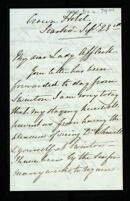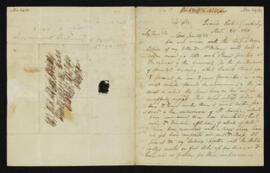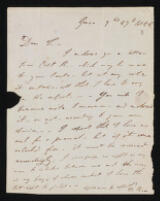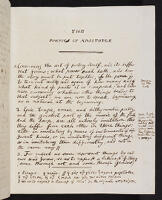Whitton Park, Hounslow. - Agrees as to inadvisability of publishing memoir of Charles Skinner Matthews: personal details of his short life, including 'passion for Whist & for boxing; will overshadow importance of a talent never fully developed; will inform Henry Matthews. Scrope Berdmore Davies had only about £200 on departure last year, but Mr Hibbert thinks he might escape calamity of income from King's College fellowship can be conveyed to him; he is at Ostend with irretrievable debts of seventeen or eighteen thousand pounds; Mr Andrews will be hardest hit'; Davies should have sought help from his friends rather than obtain money under false pretences. Hibbert's address is 47 Great Ormond Street.
"I want to see Mr Akerman to-day by all means !"
With 'The order of the service in the English Church of Amsterdam' and 'Form of the public Part of Prayer in the City of Amsterdam'.
Invitation to dinner
Kensington. Has been waiting all day for the printers
Downing Street - Thanks WW for his outline of Mont Rosa which has dispelled any certainty he still held respecting the true figure, position, and altitude of that 'mysterious hill'. JH is 'heartily sick' of the Cambridge election and dislikes all the candidates.
Genoa.
Could WW take the enclosed letters to Laplace and Edwards. Biot will introduce WW to Cuvier. If he sees Arago to ask him whether he received a letter from JH announcing his election to the Astronomical Society, and if he sees Picollet whether he got Babbage's letter on his machine. If JH's theodolite by Schenck has arrived at Bouvard's could WW take it back to England with him. The two blue pamphlets are for Cauchoix and Fortiu [the optician]. The printed letters about Babbage's machine are at his request to be given to Prony and Cauchy and any others WW may think interested.
Upper Brook Street. Requests Hodgetts to return the portrait of DR from which he was making an engraving.
Kensington. Will meet him with William Cobbett jun in the White Swan at Norwich. Asks Clarke to send on the rest of the turnip seed
Upper Brook Street. Gives adescription of his 50th birthday party, wishes her a moderate quantity of wealth.
Swansea - GA will be 'extremely glad' to have Neale as a pupil. However, further to his correspondence with Myers, he does not know whether Mr Hare had or had not already engaged a tutor for Neale. Could WW answer some questions further to the fellowship examination - 'In the first place must I sit at all? In the next place supposing that I sit, by what time must I be at Cambridge?'"
East India House. Death of David Ricardo
WW should submit his paper to the Royal Society ['A General Method of Calculating the Angles Made by Any Planes of Crystals, and the Laws According to which They are Formed', Phil. Trans., 1825]: 'Your idea of denoting every possible secondary face by one symbol (p, q, r) where p, q, r may be either + or - is excellent'. Although JH had adopted 'decrements on edges as partcular cases of decrements on angles' he 'did not think of negative decrements, which give your method its generality'.
WW does not have to personally read his paper on Crystallography to the Royal Society, but should provide an abstract of it. If read and approved it should be published in the second part of the Society Transactions for 1824 ['A General Method of Calculating the Angles Made by Any Planes of Crystals, and the Laws According to which They are Formed', Phil. Trans., 1825]. A nephew (Henry White) of two old friends of JH's has entered Queen's College to be educated for a missionary. He has no introduction at College, and consequently could become a 'Fanatic instead of a reasonable dissemination of God's word and the gifts of civilisation'. Would WW call on him and take occasional care of his progress.
Pall Mall East - DK sends WW a letter from Mr. Bowring [John Bowring?] which he thinks will answer the object of WW's communication to him.
Slough - JH has sent WW's paper to Davy 'with the character it merits (for he cannot read it) - one of the neatest applications of algebraic analysis I have seen' ['A General Method of Calculating the Angles Made by Any Planes of Crystals, and the Laws According to which They are Formed', Phil. Trans., 1825].
Trin: Coll: - Gives his 'critical' comments of WW's treatise on dynamics. He considers WW's enunciation of the laws of motion 'very far preferable to any other that I have seen'. GA emphasises the importance of attaching the same meaning to the word: 'It matters not whether there is at all such a thing as velocity in the world, provided we mathematicians know what we mean by it, and always attach the same meaning to the word. This latter is essential to logical reasoning: and in a science which is not founded on hypothesis but on experiments it is of the greatest consequence that the same word shall signify the same thing in the reports of the experiments and in the mathematical properties founded on them'. Drawing upon Atwood's machine and the philosophy of Locke, GA gives his definition of velocity: 'It is measured by causing the weights (as far as is in our power) to combine during a unit of time in the same rate of motion or at the time for which we desire to find the velocity, and the space thus described is called the velocity. To me the limit of ds/dt is rather difficult to get, but I find no difficulty in conceiving a body to continue to move with the same degree of motion which it has at any time (This perhaps appears absurd - but Locke says that we can comprehend relations between two things without having a clear idea of either)'. GA gives various mathematical corrections to WW's work: 'when I see Mr Whewell led astray in the use of the differential calculus by obscure principles and a bad notation I cannot help wishing that better were substituted'.
2 Orchard St., Portman Sq. - WW's paper on Crystallography was read at the Royal Society and an abstract will be distributed at the next meeting ['A General Method of Calculating the Angles Made by Any Planes of Crystals, and the Laws According to which They are Formed', Phil. Trans., 1825]. JH did not hear whether WW had made any reference to Levy's paper in Brewster's journal. Because of the similarity with his paper, WW should refer to it in his abstract.
Encloses an article on Charlemagne for the 'Revue Encyclopedique'
Belfast. Repudiates his attack on a banking house in Belfast
Bound unpublished manuscript with a title page laid out as if printed, including "London: John Murray, Albemarle-Street, 1824" at bottom, with "London: Printed by Thomas Davison, Whitefriars" on the verso of the half title. In the 13 page preface Buller takes issue with the editor of the second edition of Tyrwhitt's translation of The Poetics, arguing that much of Aristotle's works have been superseded by later works and discoveries and disparaging an Oxford education as never looking beyond Aristotle to Burke, Schlegel, Bacon, Locke, and other later writers. With a short post scriptum moderating the tone of his attack on the editor of the second edition of Tyrwhitt, instead placing the blame on the man's education at Oxford. The translation contains only part of Note I, and appears to be either incomplete or missing the rest of the notes, which appear in the body of the text as running up to XXVII.
Accompanied by a sheet of paper with notes in a different hand in French, Latin, and Greek laid in loose, quoting Thucydides on the plague of Athens.
Buller, Charles (1806-1848) politician and wit











![Letter from David Ricardo to [Thomas] Hodgetts](/uploads/r/trinity-college-library/3/6/b/36b445528f87cd332ae67917f2664dd1a83e4f5a5f0eb0f5fdd2d4d1f6d62ae3/011.SRMS.B19.5r.tmb.jpg)
















